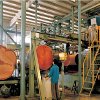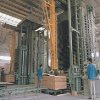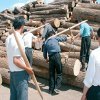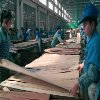China plywood is still booming
21 March 2005To say that the Chinese plywood industry is booming is, like much written about China, a gross understatement. According to official Chinese data sources, plywood production in China leaped 85% in 2003 to 21 million m3. While this magnitude of increase is probably impossible (either the 2002 data were understated, or 2003 overstated, in my opinion), the Chinese plywood industry is now probably the largest in the world, eclipsing even the US in terms of total production.
Rapidly expanding exports
Certainly there is no disputing the trade statistics, which show China moving quickly from being a major plywood importer in the late 1990s to being the world’s third largest plywood exporter in 2004 (behind only Indonesia and Malaysia).
Based on actual results through the end of November, we estimate that Chinese plywood exports in 2004 exceeded 4.2 million m3, or more than double the two million m3 exported in 2003. This is a larger volume than Malaysia exported in 2003, so it is quite possible that, in 2004/2005, China will surpass Malaysia to become the second largest plywood exporter.
More than 40% of the increase in plywood exports from China in 2004 was due to the explosive growth in exports to the US market. Those exports quadrupled in volume from around 100,000m3 in 2001 to 400,000m3 in 2003. In 2004 the flood gates opened and total exports of plywood to the US for the year were an estimated 1.3 million m3. This was approximately 31% of China’s total plywood export volume.
Another indication of the importance of the China-US trade: the International Wood Products Association (IWPA) announced in October 2004 that its “IHPA Grade Procurement Standard for Imported Hardwood Plywoodwas recently translated into Chinese, to assist Chinese producers in understanding the grades and other requirements of imported plywood produced for consumption in North America.
While exports of plywood from China to Japan and Korea (the second and third largest markets in 2004; each about 8% of China’s total export volume) have increased relatively slowly since 2002, exports to the Middle East have accelerated. For the first time, Chinese plywood exports to the Middle East region exceeded those to Japan and Korea in 2004. Exports to Europe have also increased rapidly, more than tripling in volume to an estimated 490,000m3 in 2004.
Chinese plywood exports have also been remarkably diverse. Up to the end of November, China had exported plywood to 159 countries, with exports of more than US$1m in product to 52 different countries. A Beijing firm, Chinawood International, has published an export directory for the Chinese plywood industry listing 90 companies with production greater than 3,000m3 per month, as well as some smaller, specialised firms and 26 companies involved in plywood exporting who are not producers. The directory, available from Chinawood at www.chinawood.org, or email hongfan@chinawood.org, includes contact details and production data for all major plywood companies.
Challenges facing Chinese industry
Despite the surge in plywood exports, the Chinese industry faces numerous challenges. First and foremost is the high (and increasing) cost of raw material. While much of the plywood in China is produced with domestic poplar or eucalyptus for the core, almost all face and back veneers are imported. The most important species have been okoumé and others from Africa, meranti and others from South East Asia, and birch from Russia.
The growth of the plywood industry, and especially the rapid increase in export volume, has paralleled China’s surge in imports of hardwood logs from Africa and South East Asia. Log imports from these sources totalled two million m3 in 1996, growing to 6.2 million m3 in 2001 and to more than eight million m3 in 2003.
However, as shown in the following chart, imports of African hardwood logs have plunged in 2004, dropping by 32% at the end of November compared with the previous year.
Imports from South East Asia have remained stable, but prices for all logs have increased sharply in 2004. For example, the average unit value of hardwood log imports from Africa jumped 30% in 2004, to US$260/m3, compared with the previous year. In contrast to the declining trend in imports from Africa, imports of hardwood logs from Russia increased by an estimated 13% in 2004, and now exceed the total volume of hardwood logs imported from Africa.
Of course, one factor driving the higher raw material costs in China is the weakening US dollar. The other critical factor has been the high cost of ocean freight. The combination of these factors has reduced profitability at most Chinese plywood mills, at the same time that exports have reached record levels.
At the 2004 China Wood Markets Export & Import Conference in Dalian (Oct 26-29), a panel of plywood producers complained that, despite surging exports in 2004, in the last quarter of the year a number of plywood mills had shut down because of high log prices.
But there are also other challenges facing the industry, particularly in Europe. In early 2004, the EU launched an anti-dumping investigation against imports of okoumé plywood from China. On November 12, the Official Journal published Council Regulation 1942/2004, which imposes a definitive anti-dumping duty on okoumé plywood from China. A few specific firms face a reduced duty (eg Zhonglin Enterprise (Dangshan) Co Ltd faces a 6.5% duty, while Jiaxing Jinlin Lumber Co Ltd was assigned a 17% duty). Imports from all other Chinese companies must pay an import duty of 66.7%.
But the Chinese industry is nothing if not fast on its feet – we understand in early December that a number of suppliers of okoumé plywood have already switched to using an alternative species (bintangor, or calophyllum species) from Indonesia for the face veneer, thus circumventing the duty.
There has been some concern expressed, by a very few customers, that the majority of China’s raw material for face stock is sourced from countries with serious problems of illegal logging (eg west/central Africa, South East Asia and Russia). However, to date this ‘concern’ has certainly not translated into any lack of orders for Chinese producers. Whether demand for certified products actually translates into changes in China’s raw material sourcing policies remains to be seen.
Some continue to thrive
It is true that these challenges have forced some plywood producers to shut their doors. Notable examples include Global Timber Company in Shandong Province, formerly one of the largest plywood producers in the country. Global was totally reliant on imports of high-value hardwood logs from Liberia, and when international sanctions shut down that trade (China imported zero from Liberia in 2004), the company had to fold.
Another highly public failure was Huaguang Decoration Board, at one time the largest plywood producer in China. The company acquired a large radiata pine forest in New Zealand from Rayonier, but soon afterwards had to close down due to “financial difficulties”.
It seems that a number of companies in China have jumped on the plywood band wagon in 2004 without really understanding the industry, and without having a firm handle on raw material supplies. One exception to this is Jiangsu Shengyang Industrial Joint-Stock Co Ltd. This company has long been a major supplier to the Middle East market, and has maintained a flow of raw material from Africa, in part by investing in a veneer plant in Equatorial Guinea.
Prior to entering the US market, the company had export manager James Cheng make several extended trips to visit potential customers in the US and to learn about the market. Their exports to the US have soared in 2004, and the company proudly announced that it is now producing the only MDO (medium density overlay) plywood in China, and is exporting it to the US, Canada and the UK.
Total production for Shengyang is 20,000m3 per month, including MDO, wire-mesh, film-faced concrete form panels and ‘fancy plywood’. About 70-80% of the company’s production is exported. In 2004, Shengyang also qualified for CE marking, through BM Trada in the UK.
Not all plywood companies are so heavily reliant on the export market. The Dehua TB New Decoration Material Co Ltd claims to have a leading share of the domestic market in China for its decorative plywood. Interestingly, the company early on focused on building brand recognition in the market and its Happy Rabbit brand is well known in China. While a happy rabbit might not be the most logical spokesman for a building material product in North America or Europe, this underscores the importance of understanding the culture in your target market.
The Chinese plywood industry has made rapid advances in improving product quality, however, much of the industry is still characterised by small mills and low quality.
An early exception to this was the plywood factory of CIMC Container Flooring. CIMC is the world’s largest producer of containers, and by necessity built its own plywood factory in Xinhui, in Guangdong province.
Container flooring has very high quality specifications, and the company established the first (relatively sophisticated) testing and quality assurance lab for plywood in China. The company produces about 120,000m3 of container flooring per year at its Xinhui plant and 30,000m3 at its Jiashan plant, using keruing for the face and back and eucalyptus (from imported Tasmanian regrowth logs) for the core. The company reports that it intends to expand production further in 2005.
Much has been reported in the trade press about the number of Brazilian plywood mills which have signed up with TECO or PSI/Pittsburg Testing Lab to have their panels grade-stamped for structural applications in the US market. This author was somewhat surprised to learn that Pittsburg/PSI has certified two mills in China. One mill, located north of Dalian, was producing sheathing panels for Forestwood Industries in New York state, using imported Russian pine and fir. As this article went to press, Pittsburg reported that that mill was no longer producing certified panels.
However, another mill in Linyi is producing sanded plywood with okoumé face and back and poplar core.While these panels are not for structural applications, Pittsburg reports that in January 2005 it will be visiting other interested mills in China, and it is possible other companies may also pursue this market.
Outlook for Chinese plywood
Given China’s achievements in the international plywood market, what are the prospects for future growth?
In our opinion, this breathtaking growth in plywood exports from China will slow sharply in 2005, due to increasing costs of log imports. In addition, there is likely to be some major consolidation in the Chinese plywood industry, as many of the companies who jumped on the bandwagon this year (including borrowing heavily to finance equipment purchases) will be forced to close, or in reassessing their profitability may decide to pursue other types of products.
However, the large domestic market for plywood in China and the very low labour costs there are considerable competitive advantages for the plywood industry. It seems quite likely that, despite its problems with raw material supply, the Chinese plywood industry will be a global force to be reckoned with for years to come.



